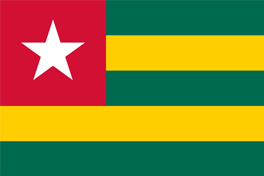 |
République togolaiseIndependence 27 April 1960
History Togo takes its name from Togodo, which means ‘village on the opposite bank’. It becomes a German protectorate in 1884. The Germans sign an agreement with the English on 1 July 1890, establishing the border between Togo and the Gold Coast (today Ghana), then with the French, on 28 September 1912, establishing the borders with Dahomey and French Sudan. After the First World War, the Treaty of Versailles of 28 June 1919 strips Germany of all its colonies; the League of Nations gives Togo to France and Great Britain. The western part of the territory is annexed to Ghana in 1956 and the eastern part, previously under French trusteeship, becomes an overseas territory. Under France, political leaders such as Nicolas Grunitzky of the Parti togolais du progrès (PTP) call for the unification of the two Togos. The Comité de l’unité togolaise (CUT) supports unification into a single British Togo. Grunitzky becomes prime minister of the Autonomous Republic of Togo in 1956. The United Nations supervises 1958 elections won by Sylvanus Olympio, who serves as prime minister until Togo’s independence on 27 April 1960. Olympio is elected president on 9 April 1961 and serves until he is assassinated during a 13 January 1963 coup d’état. At the invitation of the military, Nicolas Grunitzky takes power on 5 May 1963 and is overthrown on 13 April 1967 by General Étienne Eyadema. Togo’s declaration of independence is more like a commercial contract signed with the Compagnie minière du Bénin – through which the French consortium controls the country’s phosphate reserves – than a political victory. President Étienne Eyadema creates the Parti du rassemblement du peuple togolais (RPT) in November 1969 and adopts Mobutu’s policy of ‘returning to authenticity’. Togo and Ghana have often been at odds over the Ewe community, who straddle their common border. With its population of 500,000, Lomé, Togo’s capital, is the country’s largest city. Jacob Sabakinu Kivilu (UNIKIN) |


